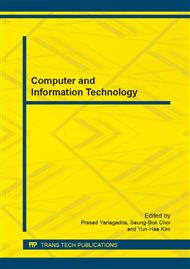[1]
D. Chaum. Blind signatures for untraceable payments. In: Advances in Cryptology: Proceedings of Crypto 1982, Plenum Publishing, New York, 1983, p.199–203.
DOI: 10.1007/978-1-4757-0602-4_18
Google Scholar
[2]
D. Chaum, A Fiat, and M Naor. Untraceable electronic cash. In: Advances in Cryptology-CRYPTO'88, LNCS 403, Springer-Verlag, 1988, p.319–327.
DOI: 10.1007/0-387-34799-2_25
Google Scholar
[3]
M. Abe and E. Fujisaki. How to date blind signatures. In: Advances in Cryptology-ASIACRYPT 1996, LNCS 1163, Springer-Verlag, 1996, p.244–251.
DOI: 10.1007/bfb0034851
Google Scholar
[4]
M. Abe and T. Okamoto. Provably secure partially blind signatures. In: Advances in Cryptology-Crypto 2000. LNCS 1880, Springer-Verlag, 2000, p.271–286.
DOI: 10.1007/3-540-44598-6_17
Google Scholar
[5]
H.F. Huang and C.C. Chang. A new design of efficient partially blind signature scheme. The Journal of Systems and Software, 73 (2013) 397–403.
DOI: 10.1016/s0164-1212(03)00237-1
Google Scholar
[6]
F. Zhang, R. Safavi-Naini, and W. Susilo. Efficient verifiably encrypted signature and partially blind signature from bilinear pairings. In: Indocrypt 2003, LNCS 2904, Springer-Verlag, 2003, p.191–204.
DOI: 10.1007/978-3-540-24582-7_14
Google Scholar
[7]
F. Li, M. Zhang, and T. Takagi. Identity-based partially blind signature in the standard model for electronic cash. Mathematical and Computer Modelling, 58 (2013) 196–203.
DOI: 10.1016/j.mcm.2012.07.009
Google Scholar
[8]
X. Hu and S. Huang. An efficient id-based partially blind signature scheme. In: 8th ACIS International Conference on Software Engineering, Artificial Intelligence, Networking and Parallel/Distributed Computing-SNPD 2007, Qingdao, China, IEEE Computer Society, 2007, p.291.
DOI: 10.1109/snpd.2007.127
Google Scholar
[9]
S. Chow, L. Hui, S. Yiu, and K. Chow. Two improved partially blind signature schemes from bilinear pairings. In: Information Security and Privacy-ACISP 2005, LNCS 3574, Springer-Verlag, 2005, p.316–328.
DOI: 10.1007/11506157_27
Google Scholar
[10]
S. Al-Riyami and K. Paterson. Certificateless public key cryptography. In: Advances in Cryptology ASIACRYPT 2003, LNCS 2894, Springer, 2003, p.452–473.
DOI: 10.1007/978-3-540-40061-5_29
Google Scholar
[11]
L. Zhang, F. Zhang, B. Qin, and S. Liu. Provably-secure electronic cash based on certificateless partially-blind signatures. Electronic Commerce Research and Applications, 10 (2011) 545–552.
DOI: 10.1016/j.elerap.2011.01.004
Google Scholar


